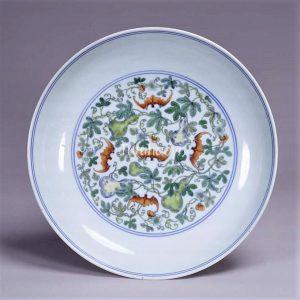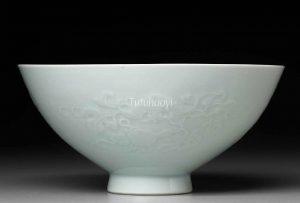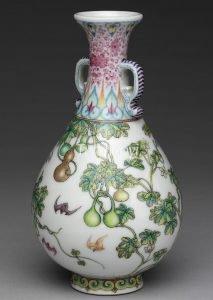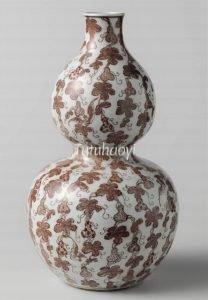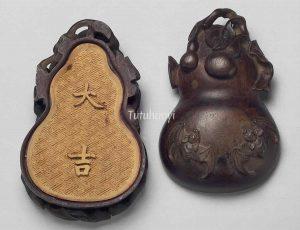May good fortune and ample official income come to your doorstep
福禄双至
© Tutuhaoyi.com owns the copyright of the description content for the images attached. Quoting all or part of the description content on this page is permitted ONLY IF ‘Tutuhaoyi.com’ is clearly acknowledged anywhere your quote is produced unless stated otherwise. (本页描述内容版权归Tutuhaoyi.com所有,转发或引用需注明 “Tutuhaoyi.com”, 侵权必究, 已注开源信息的条目除外。)
Pun Design :
Punning Details:
– hu lu (葫芦 gourd) in Chinese is pronounced similar to ‘fu (福 good fortune)’ and ‘lu (禄 official emolument)
– ‘fu 蝠’ in ‘bian fu 蝙蝠’ (meaning ‘bat’) is a pun on ‘fu 福’ (also meaning ‘good fortune’ or ‘happiness’). It is added to the image of gourd to emphasise the good wish.
画面要素: 葫芦 + 蝙蝠
谐音详情: ‘葫芦’与‘福禄’谐音;取‘蝙蝠’ 中 ‘蝠’ 与 ‘福’ 谐音,以加强祝愿。
Fig 1: porcelain dish with underglaze blue and overglaze enamelled decoration, Yongzheng period (1723–35), Qing dynasty, courtesy of Tokyo National Museum
Fig 2: porcelain bowl decorated with molded design of bats and gourds and pea-green (douqing) glaze, Yongzheng period (1723–35), Qing dynasty, courtesy of the Museum of Fine Arts, Boston
Fig 3: famille rose gourd shaped vase, Qing dynasty (1644–1911), courtesy of Tokyo National Museum
Fig 4: porcelain vase, Qianlong period (1736–95), Qing dynasty, courtesy of the National Palace Museum, Taipei
Fig 5: glass snuff-bottle with enamelled decoration, Qianlong period (1736–95), Qing dynasty, courtesy of Palace Museum, Beijing
Fig 6: glass double gourd vase with enamelled decoration, Qianlong period (1736–95), Qing dynasty, courtesy of the National Palace Museum, Taipei
Fig 7: falangcai enamelled porcelain vase, Qianlong period (1736–95), Qing dynasty, courtesy of the National Palace Museum, Taipei
Fig 8: double gourd vase, c.1750–1799, courtesy of the Rijksmuseum, Amsterdam
Fig 9-10: wooden container, Qing dynasty (1644–1911), courtesy of the National Palace Museum, Taipei
